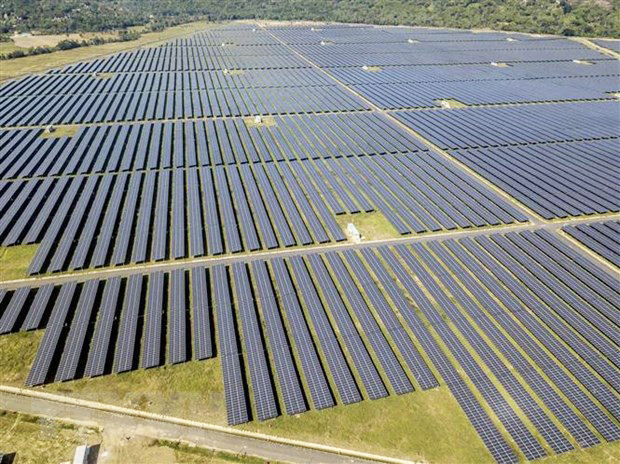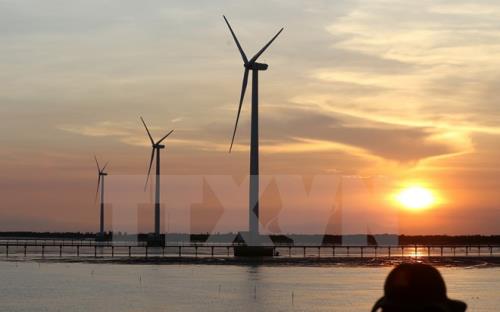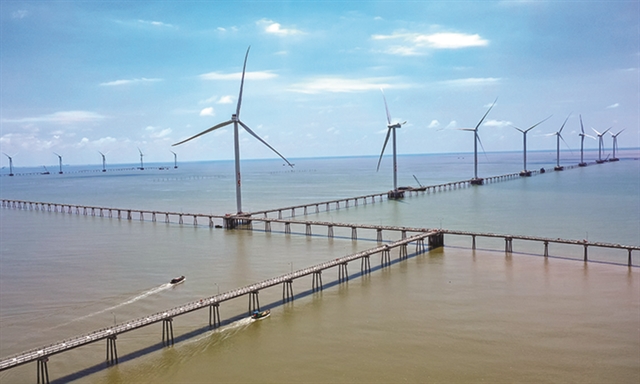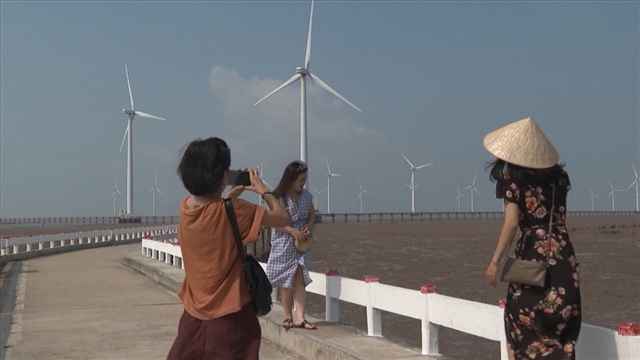
Xuân Hiệp & Việt Dũng
HCM CITY — The Cửu Long (Mekong) Delta will need to optimise its natural conditions to develop renewable energy and attract investment in the sector to mitigate the impacts of climate change, experts have said.
The region has much potential for renewables like wind, solar and biomass, they said.
It has a long coastline of around 700km, which has great potential to develop wind power since it gets winds of 6.5-7m per second. The potential for wind power is estimated at 1,200-1,500MW.
Eleven of 13 cities and provinces in the region also have enormous potential for solar energy.
A recent study by the German Agency for International Cooperation (GIZ) showed that the region gets an average of 2,200-2,500 hours of sunshine a year, and strong enough on more than 90 per cent of the days to operate solar panels. The average radiation per year is 1,387-1,534 kWh/kWp.
The potential of ocean waves, tidal energy and the abundant biomass from more than 23 million tonnes of agricultural by-products a year has not been fully exploited.
Investment needed
Not until recently have delta provinces stepped up efforts to seek investment in clean and renewable energies.
Cà Mau Province is seeking investors in clean energy projects.
Dương Vũ Nam, deputy director of its Department of Industry and Trade, said the southernmost province has a coastline of 254km, which is excellent for wind power development.
Cà Mau’s long coastline and islands are also ideal for building warehouses and ports and installing gas pipelines and storage and regasification systems to develop gas-fired power.
Dozens of domestic and foreign investors have also expressed keen interest in wind, solar and biomass power generation in the province.
It has 11 wind power plants with a total capacity of 675MW, while a 24MW biomass project is under construction. It has approved a 200MW wind power project that is expected to go on stream next year.
It wants the Ministry of Industry and Trade to add 26 wind power projects with a total capacity of 14,614MW proposed to be built in the province to the National Electricity Development Plan for until 2030.
Local businesses have been using solar power to make use of the local abundance of sunlight.
Tân Phát Lợi Co-operative Group, which produces prawn crackers and dried shrimp and fish, has invested in food drying technology that uses solar energy.
It reduces harmful carbon emissions compared to the traditional food drying method using charcoal.
Tài Thịnh Phát Farm Co-operative Group invested VNĐ300 million (US$13,000) in a solar-powered drying facility for its dried shrimp processing.
While the province does not have any solar farms, more and more households and businesses are installing rooftop solar.
With over 300,000 hectares under aquaculture in the province, many domestic and foreign investors are interested in setting up solar power projects to supply to farmers and businesses.
It has a tropical monsoon climate, relatively high temperatures and over 2,000 hours of sunlight a year.
The province also has high solar radiation and large forest areas that provide 225,000-300,000 tonnes of waste wood annually from wood production and processing.
It plans to build nine solar power plants with a total capacity of over 2,800MW.

Bạc Liêu Province is also soliciting investment in renewable energy from domestic and foreign sources.
Last month, the first phase of the Hòa Bình No 5 onshore wind power plant with a capacity of 80MW was inaugurated in Vĩnh Thịnh Commune, Hòa Bình District, the largest of its kind in the delta.
The investor is Hacom Bạc Liêu Energy Joint Stock Company, a member of Hacom Holdings.
Its chairman, Trần Phú Chiến, said his firm also plans to build 300MW of offshore and other wind power projects in the province.
Bạc Liêu’s wind power plants also play a role in promoting tourism by attracting around 1,000 visitors every day since the wind turbines make for popular tourist attractions and photo-taking opportunities.
It was one of the first provinces to open its wind power projects to tourists in 2018, allowing it to fully utilise its coastal potential.
According to the provincial Department of Industry and Trade, wind power output in the first five months topped 447 million kWh, four times the output in the same period last year.
Solar power output reached 5.8 million kWh, a 17 per cent increase.
It currently has eight wind power projects in operation with a total capacity of 469.2MW, the third highest in the country.


Challenges
Despite the region’s great potential in renewable energy, challenges do exist, resulting in slow implementation of projects.
Dương Vũ Nam, deputy director of the Cà Mau Department of Industry and Trade, said the slow implementation is caused by problems related to changes in land use, land clearance and administrative procedures for construction.
Cà Mau has 300,000 hectares of aquaculture. Solar panels could be installed over the breeding ponds, but there are still no guidelines for this.
The provincial Department of Industry and Trade has called for such guidelines besides creating favourable conditions to attract investors.
The province is speeding up work on installing 220kV and 110kV transmission lines to connect its renewable energy projects with the national grid.
The Sóc Trăng Province Department of Industry and Trade has helped investors resolve difficulties to speed up the work on 20 wind power plants. It has called for building two 110kV transmission lines and a 220kV transformer station to link up with them.
It is working with other agencies to develop models that combine solar power with agriculture and aquaculture.
Speaking at a recent meeting with the media, Dutch ambassador to Việt Nam, Elsbeth Akkerman, said the country has everything to become a renewable energy superpower, with the Mekong Delta playing a major role.
The delta is a major agriculture-aquaculture-mangrove hub, that provides a lot of biomass.
With its long coastline and availability of strong winds, Việt Nam is well positioned to fully meet its energy demand with renewables and even become an energy exporter, Akkerman said.
“The solar energy revolution has largely taken off in the past two years and growth in the wind energy sector is expected in the next five to 10 years.” — VNS
Xem thêm: lmth.ygrene-elbawener-fo-tnempoleved-dipar-seye-atled-gnokem/2280521/ymonoce/nv.swenmanteiv